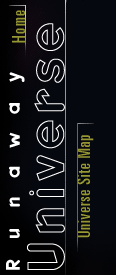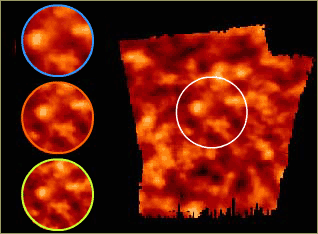 |
 |
Microwave Background Radiation
Back to How Big is the Universe?

As we look out in space we look back in time. It was a great discovery to find we could look all the way back to only a half million years after the big bang, when the universe was so hot that all gas was ionized.
Slightly denser places in that early universe were slightly cooler. The physical sizes of the hot and cool spots are related to the distance that acoustic waves propagating near the speed of light could travel in the half million years available. The observed sizes of these spots are distorted by the shape of the universe, governed by the average mass-energy density.
The balloon experiment filmed in the "Runaway Universe" produced the map shown here of a tiny part of the sky. The mottling reveals hotter and cooler regions in the early universe. The size of these mottles tells us something about the geometry of the universe, and hence, about the average matter-energy density. Consider the three models presented in the first animation. The yellow low-density model gives rise to an "open" universe where light is curved in a way that makes angles smaller—i.e., the scene is shrunk. The blue high-density model corresponds to a "closed" universe where angles are bigger—i.e., the scene is magnified. The red model, with a mix of matter and energy, corresponds to a "flat" universe with no global distortion.
These examples are only three of a continuum of possibilities. However, only a narrow range of possibilities are consistent with this map, which shows that patterns in the radiation from the distant past are neither magnified nor demagnified. The mottles are the size expected for the "flat" universe predicted by the theory of inflation.
History of the Universe |
Birth of a Supernova |
Tour the Universe
Moving Targets |
How Big is the Universe? |
Spin a Spiral Galaxy
Resources |
Transcript |
Site Map |
Runaway Universe Home
Editor's Picks |
Previous Sites |
Join Us/E-mail |
TV/Web Schedule
About NOVA |
Teachers |
Site Map |
Shop |
Jobs |
Search |
To print
PBS Online |
NOVA Online |
WGBH
© | Updated November 2000
|
|
|